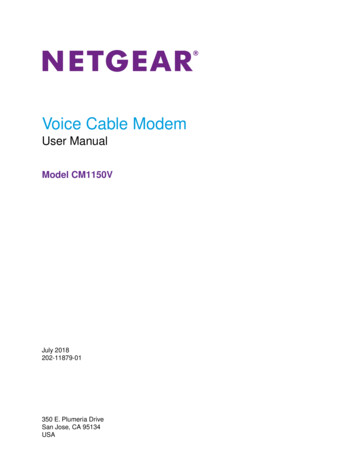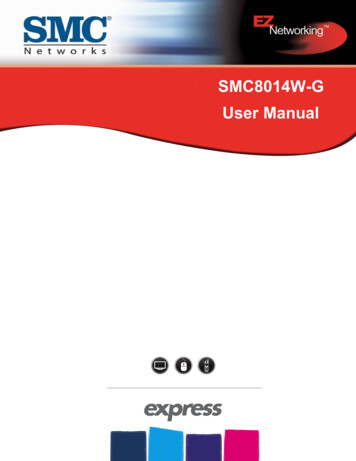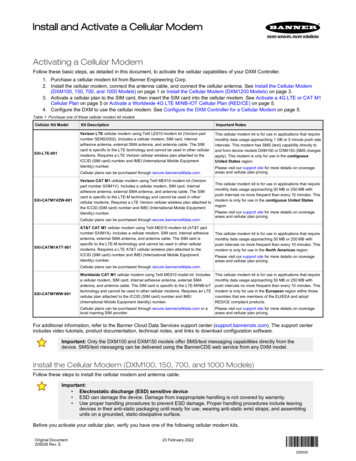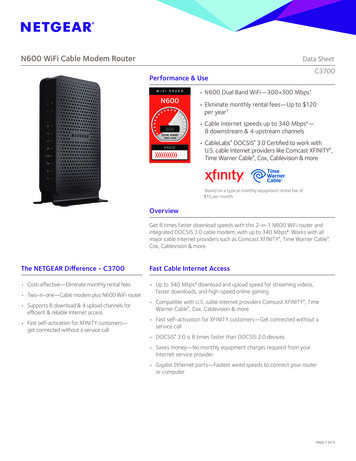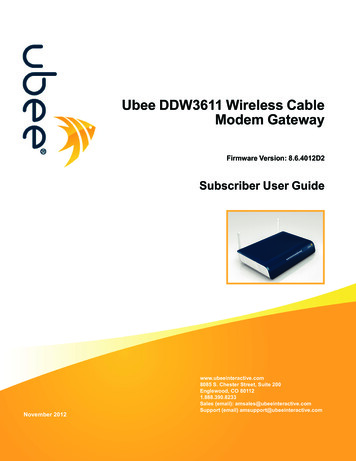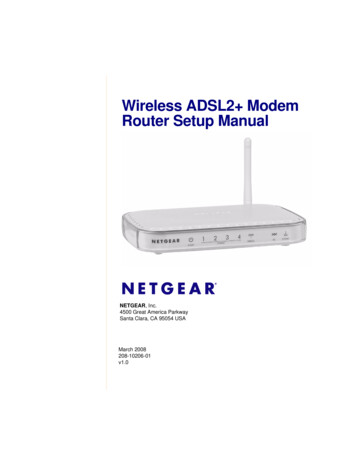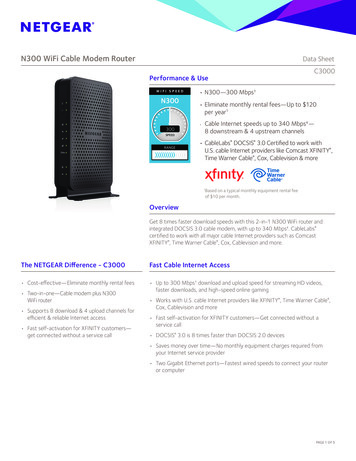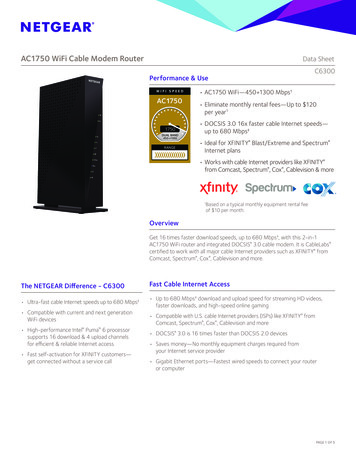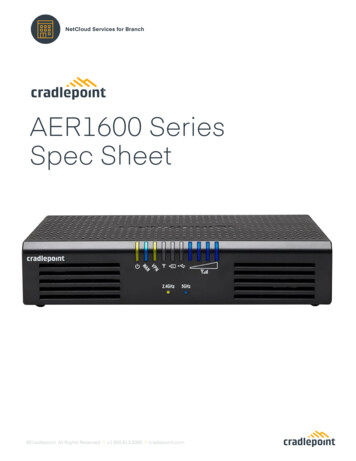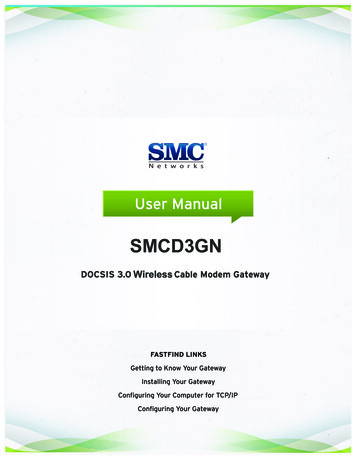
Transcription
SMCD3GNWireless
SMC Networks20 MasonIrvine, CA. 92618U.S.A.Copyright 2010 SMC NetworksAll Rights ReservedInformation furnished by SMC Networks, Inc. (SMC) is believed to be accurate and reliable. However,no responsibility is assumed by SMC for its use, or for any infringements of patents or other rights ofthird parties which may result from its use. No license is granted by implication or otherwise underany patent or patent rights of SMC. SMC reserves the right to change specifications at any timewithout noticeNo part of this publication may be reproduced or transmitted in any form or by any means, electronicor mechanical, including photocopying and recording, or stored in a database or retrieval system forany purpose without the express written permission of SMC.Microsoft and Windows are registered trademarks of Microsoft Corporation. Apple and Macintosh areregistered trademarks of Apple, Inc. All other brands, product names, trademarks, or service marksare property of their respective owners.SMCD3GN Wireless Cable Modem Gateway User Manual
ContentsPreface. vKey Features . viDocument Organization.viiDocument Conventions .viiSafety and Warnings .viiTypographic Conventions.viii1 Getting to Know Your Gateway . 9Unpacking Package Contents . 10System Requirements . 10Front Panel. 11Configuring Wireless Security . 13Rear Panel . 13Restoring Factory Defaults. 142 Installing Your Gateway . 15Finding a Suitable Location . 16Connecting to the LAN . 16Connecting the WAN. 17Powering on the Gateway . 173 Configuring Your Computer for TCP/IP . 18Configuring Microsoft Windows 2000. 19Configuring Microsoft Windows XP . 20Configuring Microsoft Windows Vista. 21Configuring an Apple Macintosh Computer . 234 Configuring Your Gateway . 24Pre-configuration Guidelines . 25Disabling Proxy Settings. 25Disabling Proxy Settings in Internet Explorer . 25Disabling Proxy Settings in Firefox . 25Disabling Proxy Settings in Safari . 26Disabling Firewall and Security Software . 26Confirming Your Gateway’s Link Status . 26Accessing the Gateway’s Web Management . 27Understanding the Web Management Interface Screens . 28iiiSMCD3GN Wireless Cable Modem Gateway User Manual
ContentsWeb Management Interface Menus . 29System Settings Menu. 30Password Settings Menu. 31LAN Settings Menu. 32Ether Switch Port Control Menu . 33Wireless Basic Settings Menu . 35Wireless Encryption Settings Menu. 36MAC Filtering. 39Advanced Wireless Settings Menu. 41Port Forwarding Menu . 43Adding a Port Forwarding Entry for a Predefined Service . 43Adding a Port Forwarding Entry for a Customer-Defined Service . 45Security Settings (Firewall) Menu. 48Enabling or Disabling Firewall . 48Configuring Access Control . 49Configuring Special Applications . 49Configuring URL Blocking . 52Configuring Schedule Rules . 54Configuring Email and Syslog Alerts . 55Configuring DMZ Settings . 58Using the Reboot Menu to Reboot the Gateway . 59Viewing Status Information. 60Viewing Cable Status Information . 62Appendix A - Specifications . 63Appendix B - Compliances . 67Index . 68ivSMCD3GN Wireless Cable Modem Gateway User Manual
PrefaceCongratulations on your purchase of the SMCD3GN Wireless Cable Modem Gateway. TheSMCD3GN Wireless Cable Modem Gateway is the ideal all-in-one wired and wirelesssolution for the home or business environment. SMC is proud to provide you with a powerful,yet simple communication device for connecting your local area network (LAN) to theInternet.This user manual contains all the information you need to install and configure your newSMCD3GN Wireless Cable Modem Gateway.vSMCD3GN Wireless Cable Modem Gateway User Manual
PrefaceKey FeaturesThe following list summarizes the Gateway’s key features.yIntegrated, CableLabs-compliant DOCSIS 1.1/ 2.0 /3.0 cable modem.yIntegrated cable modem port for Internet connection to cable modem service.yFour 10/100/1000 Mbps Auto-Sensing LAN ports with Auto-MDI/MDIX.yHigh-speed 300 Mbps IEEE 802.11n Wireless Access Point.yInternet connection to cable modem service via an integrated cable modem port.yDynamic Host Configuration Protocol (DHCP) for dynamic IP configuration, and DomainName System (DNS) for domain name mapping.yOne USB 2.0 port.yIEEE 802.11 b/g/n interoperability with multiple vendors.yWireless WEP, WPA, and WPA2 encryption, Hide SSID, and MAC Filtering.yVPN pass-through support using PPTP, L2TP, or IPSec.yAdvanced SPI firewall Gateway for enhanced network security from attacks over theInternet:–Firewall protection with Stateful Packet Inspection–Client privileges–Hacker prevention–Protection from denial of service (DoS) attacks–Network Address Translation (NAT)yUniversal Plug and Play (UPnP) enables any UPnP device seamlessly.yQuality of Service (QoS) ensures high-quality performance with existing networks.yEffortless plug-and-play installation.yIntuitive graphical user interface (GUI) configuration, regardless of operating system.yComprehensive front panel LEDs for network status and troubleshooting.yCompatible with all popular Internet applications.viSMCD3GN Wireless Cable Modem Gateway User Manual
PrefaceDocument OrganizationThis document consists of four chapters and two appendixes.yChapter 1 - describes the contents in your Gateway package, system requirements, andan overview of the Gateway’s front and rear panels.yChapter 2 - describes how to install your Gateway.yChapter 3 - describes how to configure TCP/IP settings on the computer you will use toconfigure your Gateway.yChapter 4 - describes how to configure your Gateway.yAppendix A - lists the Gateway’s specifications.yAppendix B - contains compliance information.Document ConventionsThis document uses the following conventions to draw your attention to certain information.Safety and WarningsThis document uses the following symbols to draw your attention to certain information.SymbolMeaningDescriptionNoteNotes emphasize or supplement important points of the main text.TipTips provide helpful information, guidelines, or suggestions for performing tasks moreeffectively.WarningWarnings indicate that failure to take a specified action could result in damage to thedevice.Electric Shock HazardThis symbol warns users of electric shock hazard. Failure to take appropriateprecautions such as not opening or touching hazardous areas of the equipment couldresult in injury or death.viiSMCD3GN Wireless Cable Modem Gateway User Manual
PrefaceTypographic ConventionsThis document also uses the following typographic conventions.ConventionDescriptionBoldIndicates text on a window, other than the window title, including menus, menu options, buttons, fields, and labels.ItalicIndicates a variable, which is a placeholder for actual text provided by the user or system. Angled brackets ( )are also used to indicate variables.screen/codeIndicates text that is displayed on screen or entered by the user. angledbracketsIndicates a variable, which is a placeholder for actual text provided by the user or system. Italic font is also used toindicate variables.[ ] squarebracketsIndicates optional values.{ } bracesIndicates required or expected values. vertical barIndicates that you have a choice between two or more options or arguments.viiiSMCD3GN Wireless Cable Modem Gateway User Manual
1 Getting to Know Your GatewayBefore you install your SMCD3GN Wireless Cable Modem Gateway, check the packagecontents and become familiar with the Gateway’s front and back panels.The topics covered in this chapter are:yUnpacking Package Contents (page 10)ySystem Requirements (page 10)yFront Panel (page 11)yConfiguring Wireless Security (page 13)yRear Panel (page 13)yRestoring Factory Defaults (page 14)9SMCD3GN Wireless Cable Modem Gateway User Manual
Getting to Know Your GatewayUnpacking Package ContentsUnpack the items in your SMCD3GN Wireless Cable Modem Gateway contents and confirmthat no items are missing or damaged. Your package should include:yOne SMCD3GN Wireless Cable Modem GatewayyOne Power adapter (12V/2A)yOne Category 5E Ethernet cableyOne CD that contains this User ManualIf any items are missing or damaged, please contact your place of purchase. Keep thecarton, including the original packing material, in case you need to store the product orreturn it.System RequirementsTo complete your installation, you will need the following items:yProvisioned Internet access on a cable network that supports cable modem service.yA computer with a wired network adapter with TCP/IP installed.yA Java-enabled Web browser, such as Microsoft Internet Explorer 5.5 or above.yMicrosoft Windows 2000 or higher for USB driver support.10SMCD3GN Wireless Cable Modem Gateway User Manual
Getting to Know Your GatewayFront PanelThe front panel of your SMCD3GN Wireless Cable Modem Gateway contains a set of lightemitting diode (LED) indicators. These LEDs show the status of your Gateway and simplifytroubleshooting.Figure 1 shows the front panel of the SMCD3GN Wireless Cable Modem Gateway. Table 1describes the front panel LEDs.Figure 1. Front Panel of the SMCD3GN Wireless Cable Modem Gateway11SMCD3GN Wireless Cable Modem Gateway User Manual
Getting to Know Your GatewayTable 1. Front Panel LEDsLEDPOWERColorGreenDescriptionON power is supplied to the Gateway.OFF power is not supplied to the Gateway.DSGreenBlinking scanning for DS channel.ON synchronized on 1 channel only.BlueDS and USUSON synchronized with more than 1 channel (DS Bond mode).Both DS and US blinking together operator is performing maintenance.GreenBlinking ranging is in progress.ON ranging is complete on 1 channel only.OFF scanning for DS channel.ONLINEBlueON ranging is complete, operate with more than 1 channel (US Bond mode).GreenBlinking .cable interface is acquiring IP, ToD, CM configuration.ON Gateway is operational.OFF Gateway is offline.LINKGreenBlinking data is transmitting.ON Gateway is operational.OFF no Ethernet link detected.DIAGAmberON system failure.OFF normal operation.LAN 1 – LAN 4GreenBlinking data is transmitting.ON connected at 10 or 100 Mbps.OFF no Ethernet link detected.BlueBlinking data is transmitting.ON connected at 1 GMbps.OFF no Ethernet link detected.WIFIGreenBlinking data is transmitting.ON Wi-Fi is enabled.OFF Wi-Fi is disabled.USBGreenReserved for future use.12SMCD3GN Wireless Cable Modem Gateway User Manual
Getting to Know Your GatewayConfiguring Wireless SecurityThe front panel has a WPS button for configuring wireless security automatically. Pressingthis button for 5 seconds automatically configures wireless security. If the client devicesupports WPS Push Button Configuration (PBC), press the button within 60 seconds toautomatically configure security on the client.After pressing this button for 5 seconds, the WPS LED on the front panel flashes. When aclient joins the network successfully, the LED goes ON until the next WPS action or thedevice reboots. If no client joins, the LED stops blinking after 4 minutes.Rear PanelThe rear panel of your SMCD3GN Wireless Cable Modem Gateway contains a reset buttonand the ports for attaching the supplied power adapter and making additional connections.Figure 2 shows the rear panel components and Table 2 describes their meanings. Figure 2. Rear View of the SMCD3GN Wireless Cable Modem GatewayTable 2. SMCD3GN Wireless Cable Modem Gateway Rear Panel ComponentsItemDescription Power (12VDC)Connect the supplied power adapter to this port. LAN 1-4Four 10/100/1000 auto-sensing RJ-45 switch ports. Connect devices on your local area networksuch as a computer, hub, or switch to these ports. USBUSB 2.0 high-speed port for storing configurations externally. CableConnect your coaxial cable line to this port. Reset buttonUse this button to reset the power or restore the default factory settings (see “Restoring FactoryDefaults,” below). This button is recessed to prevent accidental resets of your Gateway.13SMCD3GN Wireless Cable Modem Gateway User Manual
Getting to Know Your GatewayRestoring Factory DefaultsUsing the Reset button on the back panel, you can power cycle the Gateway and return it toits original factory default settings. As a result, any changes you made to the Gateway’sdefault settings will be removed. To reset the Gateway and keep any overrides you made tothe factory default settings, use the software reset method described under “Using theReboot Menu to Reboot the Gateway” on page 59.1. Leave power plugged into the Gateway.2. Find the Reset button on the back panel, then press and hold it for at least 10 seconds.3. Release the Reset button.14SMCD3GN Wireless Cable Modem Gateway User Manual
2 Installing Your GatewayThis chapter describes how to install your SMCD3GN Wireless Cable Modem Gateway. Thetopics covered in this chapter are:yFinding a Suitable Location (page 16)yConnecting to the LAN (page 16)yConnecting the WAN (page 17)yPowering on the Gateway (page 17)15SMCD3GN Wireless Cable Modem Gateway User Manual
Installing Your GatewayFinding a Suitable LocationYour SMCD3GN Wireless Cable Modem Gateway can be installed in any location withaccess to the cable network. All of the cables connect to the rear panel of the Gateway forbetter organization and utility. The LED indicators on the front panel are easily visible toprovide you with information about network activity and status.For optimum performance, the location you choose should:yBe close to a working AC power outlet.yAllow sufficient air flow around the Gateway to keep the device as cool as possible.yNot expose the Gateway to a dusty or wet environment.yBe an elevated location such as a high shelf, keeping the number of walls and ceilingsbetween the Gateway and your other devices to a minimum.yBe away from electrical devices that are potential sources of interference, such as ceilingfans, home security systems, microwaves, or the base for a cordless phone.yBe away from any large metal surfaces, such as a solid metal door or aluminum studs.Large expanses of other materials such as glass, insulated walls, fish tanks, mirrors,brick, and concrete can also affect your wireless signal.Connecting to the LANUsing an Ethernet LAN cable, you can connect the Gateway to a desktop computer,notebook, hub, or switch. Your Gateway supports auto-MDI/MDIX, so you can use either astandard straight-through or crossover Ethernet cable.1. Connect either end of an Ethernet cable to one of the four LAN ports on the rear panel ofthe Gateway (see Figure 3).Figure 3. Connecting to a LAN Port on the Gateway Rear Panel16SMCD3GN Wireless Cable Modem Gateway User Manual
Installing Your Gateway2. Connect the other end of the cable to your computer’s network-interface card (NIC) or toanother network device (see Figure 4).Figure 4. Connecting the Gateway to the a Laptop or Desktop ComputerConnecting the WANTo connect your Gateway to a Wide Area Network (WAN) interface:1. Connect a coaxial cable to the port labeled Cable on the rear panel of the Gateway from acable port in your home or office (see Figure 2 on page 13). Use only manufactured coaxialpatch cables with F-type connectors at both ends for all connections.2. Hand-tighten the connectors to secure the connection.3. If the modem was not installed by your cable provider (ISP) or is replacing another cablemodem, contact your cable operator to register the SMCD3GN. If the modem is notregistered with your cable operator, it will be unable to connect to the cable networksystem.Powering on the GatewayAfter making your LAN and WAN connections, use the following procedure to power on theGateway:1. Connect the supplied power adapter to the port labeled 12VDC on the rear panel of theGateway (see Figure 2 on page 13).2. Connect the other end of the power adapter to a working power outlet. The Gatewaypowers on automatically, the POWER LED on the front panel goes ON, and the other frontpanel LEDs show the Gateway’s status (see Table 1 on page 12).WARNING: Only use the power adapter supplied with the Gateway. Using a different poweradapter can damage your Gateway and void the warranty.17SMCD3GN Wireless Cable Modem Gateway User Manual
3 Configuring Your Computer for TCP/IPAfter you install your SMCD3GN Wireless Cable Modem Gateway, configure the TCP/IPsettings on a computer that will be used to configure your Gateway. This chapter describeshow to configure TCP/IP for various Microsoft Windows and Apple Macintosh operatingsystems.The topics covered in this chapter are:yConfiguring Microsoft Windows 2000 (page 19)yConfiguring Microsoft Windows XP (page 20)yConfiguring Microsoft Windows Vista (page 21)yConfiguring an Apple Macintosh Computer (page 23)18SMCD3GN Wireless Cable Modem Gateway User Manual
Configuring Your Computer for TCP/IPConfiguring Microsoft Windows 2000Use the following procedure to configure your computer if your computer has MicrosoftWindows 2000 installed.1. On the Windows taskbar, click Start, point to Settings, and then click Control Panel.2. In the Control Panel window, double-click the Network and Dial-up Connections icon. Ifthe Ethernet adapter in your computer is installed correctly, the Local Area Connectionicon appears.3. Double-click the Local Area Connection icon for the Ethernet adapter connected to theGateway. The Local Area Connection Status dialog box appears (see Figure 5).Figure 5. Local Area Connection Status Window4. In the Local Area Connection Status dialog box, click the Properties button. The LocalArea Connection Properties dialog box appears.5. In the Local Area Connection Properties dialog box, verify that Internet Protocol (TCP/IP)is checked. Then select Internet Protocol (TCP/IP) and click the Properties button.6. Click Obtain an IP address automatically to configure your computer for DHCP.7. Click the OK button to save this change and close the Local Area Connection Propertiesdialog box.8. Click OK button again to save these new changes.9. Restart your computer.19SMCD3GN Wireless Cable Modem Gateway User Manual
Configuring Your Computer for TCP/IPConfiguring Microsoft Windows XPUse the following procedure to configure a computer running Microsoft Windows XP with thedefault interface. If you use the Classic interface, where the icons and menus resembleprevious Windows versions, perform the procedure under “Configuring Microsoft Windows2000” on page 19.1. On the Windows taskbar, click Start, click Control Panel, and then click Network andInternet Connections.2. Click the Network Connections icon.3. Click Local Area Connection for the Ethernet adapter connected to the Gateway. TheLocal Area Connection Status dialog box appears.4. In the Local Area Connection Status dialog box, click the Properties button (see Figure 6).The Local Area Connection Properties dialog box appears.Figure 6. Local Area Connection Status Window5. In the Local Area Connection Properties dialog box, verify that Internet Protocol (TCP/IP)is checked. Then select Internet Protocol (TCP/IP) and click the Properties button. TheInternet Protocol (TCP/IP) Properties dialog box appears.6. In the Internet Protocol (TCP/IP) Properties dialog box, click Obtain an IP addressautomatically to configure your computer for DHCP. Click the OK button to save thischange and close the Internet Protocol (TCP/IP) Properties dialog box.7. Click the OK button again to save your changes.8. Restart your computer.20SMCD3GN Wireless Cable Modem Gateway User Manual
Configuring Your Computer for TCP/IPConfiguring Microsoft Windows VistaUse the following procedure to configure a computer running Microsoft Windows Vista withthe default interface. If you use the Classic interface, where the icons and menus resembleprevious Windows versions, perform the procedure under “Configuring Microsoft Windows2000” on page 19.1. On the Windows taskbar, click Start, click Control Panel, and then select Network andInternet Icon.2. Click View Networks Status and tasks and then click Management NetworksConnections.3. Right-click the Local Area Connection icon and click Properties.4. Click Continue. The Local Area Connection Properties dialog box appears.5. In the Local Area Connection Properties dialog box, verify that Internet Protocol(TCP/IPv4) is checked. Then select Internet Protocol (TCP/IPv4) and click theProperties button (see Figure 7). The Internet Protocol Version 4 Properties dialog boxappears.Figure 7. Local Area Connection Properties Window21SMCD3GN Wireless Cable Modem Gateway User Manual
Configuring Your Computer for TCP/IP6. In the Internet Protocol Version 4 Properties dialog box, click Obtain an IP addressautomatically to configure your computer for DHCP (see Figure 8).Figure 8. Internet Protocol Properties Window7. Click the OK button to save your changes and close the dialog box.8. Click the OK button again to save your changes.Figure 9. Local Area Connection Status Window22SMCD3GN Wireless Cable Modem Gateway User Manual
Configuring Your Computer for TCP/IPConfiguring an Apple Macintosh ComputerThe following procedure describes how to configure TCP/IP on an Apple Macintosh runningMac OS 10.2. If your Apple Macintosh is running Mac OS 7.x or later, the steps you performand the screens you see may differ slightly from the following. However, you should still beable to use this procedure as a guide to configuring your Apple Macintosh for TCP/IP.1. Pull down the Apple Menu, click System Preferences, and select Network.2. Verify that NIC connected to the SMCD3GN is selected in the Show field.3. In the Configure field on the TCP/IP tab, select Using DHCP (see Figure 10).4. Click Apply Now to apply your settings and close the TCP/IP dialog box.Figure 10. Selecting Using DHCP in the Configure Field23SMCD3GN Wireless Cable Modem Gateway User Manual
4 Configuring Your GatewayAfter configuring your computer for TCP/IP using the procedure appropriate for youroperating system, use that computer’s Web browser to configure your SMCD3GN Gateway.This chapter describes how to use your Web browser to configure your Gateway.The topics covered in this chapter are:yPre-configuration Guidelines (page 25)yAccessing the Gateway’s Web Management (page 27)yUnderstanding the Web Management Interface Screens (page 28)yWeb Management Interface Menus (page 29)24SMCD3GN Wireless Cable Modem Gateway User Manual
Pre-configuration GuidelinesBefore you configure your Gateway, observe the guidelines in the following sections.Disabling Proxy SettingsDisable proxy settings in your Web browser. Otherwise, you will not be able to view theGateway’s Web-based configuration pages.Disabling Proxy Settings in Internet ExplorerThe following procedure describes how to disable proxy settings in Internet Explorer 5 andlater.1. Start Internet Explorer.2. On your browser’s Tool menu, click Options. The Internet Options dialog box appears.3. In the Internet Options dialog box, click the Connections tab.4. In the Connections tab, click the LAN settings button. The Local Area Network (LAN)Settings dialog box appears.5. In the Local Area Network (LAN) Settings dialog box, uncheck all check boxes.6. Click OK until the Internet Options window appears.7. In the Internet Options window, under Temporary Internet Files, click Settings.8. For the option Check for newer versions of stored pages, select Every time I visit thewebpage.9. Click OK until you close all open browser dialog boxes.Disabling Proxy Settings in FirefoxThe following procedure describes how to disable proxy settings in Firefox.1. Start Firefox.2. On your browser’s Tools menu, click Options. The Options dialog box appears.3. Click the Advanced tab.4. In the Advanced tab, click the Network tab.5. Click the Settings button.6. Click Direct connection to the Internet.7. Click the OK button to confirm this change.25SMCD3GN Wireless Cable Modem Gateway User Manual
Configuring Your GatewayDisabling Proxy Settings in SafariThe following procedure describes how to disable proxy settings in Safari.1. Start Safari.2. Click the Safari menu and select Preferences.3. Click the Advanced tab.4. In the Advanced tab, click the Change Settings button.5. Choose your location from the Location list (this is generally Automatic).6. Select your connection method. If using a wired connection, select Built-in Ethernet. Forwireless, select Airport.7. Click the Proxies tab.8. Be sure each proxy in the list is unchecked.9. Click Apply Now to finish.Disabling Firewall and Security SoftwareDisable any firewall or security software that may be running on your computer. For moreinformation, refer to the documentation for your firewall.Confirming Your Gateway’s Link StatusConfirm that the LINK LED on the Gateway front panel is ON (see Figure 1 on page 11). Ifthe LED is OFF, replace the Ethernet cable connecting your computer and Gateway.26SMCD3GN Wireless Cable Modem Gateway User Manual
Configuring Your GatewayAccessing the Gateway’s Web ManagementAfter configuring your computer for TCP/IP and performing the preconfiguration guidelineson the previous page, you can now easily configure your Gateway from the convenient Webbased management interface. From your Web browser (Microsoft Internet Explorer orNetscape Navigator, versions 5.0 or later), you will log in to the interface to define systemparameters, change password settings, view status windows to monitor network conditions,and control the Gateway and its ports.To access the
Preface Key Features The following list summarizes the Gateway's key features. y Integrated, CableLabs-compliant DOCSIS 1.1/ 2.0 /3.0 cable modem. y Integrated cable modem port for Internet connection to cable modem service. y Four 10/100/1000 Mbps Auto-Sensing LAN ports with Auto-MDI/MDIX. y High-speed 300 Mbps IEEE 802.11n Wireless Access Point. y Internet connection to cable modem service .
